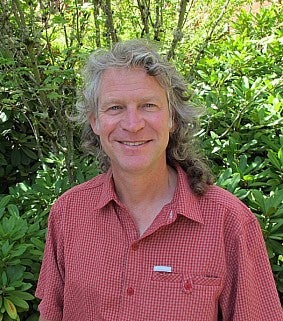Faculty bio | Research website | 541-346-4741
Biography:
Physicist Richard Taylor is internationally known for his innovation using bioinspiration to improve health and wellbeing. He has published more than 300 papers, including 11 papers Nature and 3 in Science. His work has been featured in TV documentaries and the subject of articles in The New York Times, Scientific American, The New Yorker, as well as popular science books. Taylor studies fractals in physics, psychology, physiology, geography, architecture and art. He designed bio-inspired retinal implants to restore vision to victims of retinal diseases. His other work uses bio-inspired fractal images to reduce people's stress levels in the built environment, such as in carpets. He also uses computer analysis to study and authenticate art works and is considered the leading expert on the artist Jackson Pollock.
Taylor regularly gives lectures around the world, invited by organizations as diverse as the Nobel Foundation, the White House, the Royal Society and national art galleries such as the Pompidou Centre and the Guggenheim Museum.
Recent Media:
- Fractals: Nature’s healing patterns in design (Metropolis Magazine, Sept. 12, 2025)
- Trees in art, as well as life, often follow simple mathematical rules, study finds (CNN, March 14, 2025)
- University of Oregon professor trains AI to distinguish between real and fake Jackson Pollock paintings (Oregon Public Broadcasting, July 12, 2024)
- Artificial intelligence can spot art forgeries, study finds (OregonNews, June 17, 2024)
- Deep Calm - Episode 4: Using the Power of Nature (BBC, May 17, 2024)
- Oregon scientists are building a better bionic eye (Oregon Public Broadcasting, Sept. 13, 2023)
- Ready to chill out? Look no further than nature’s fractals. (Sierra Club Magazine, Aug. 24, 2022)
- Bio-inspired technology could one day lead to a bionic eye (OregonNews, April 8, 2022)
- The human brain would rather look at nature than city streets (OregonNews, March 9, 2022)
- Why our "wandering brains" are wired to love art and nature (Salon, June 15, 2021)
- Oregon researchers unveil the weaving fractal network of connecting neurons (EurekAlert, March, 2, 2021)
- Study finds that by age 3 kids prefer nature's fractal patterns (OregonNews, Dec. 11, 2020)
- Feeling Anxious? Houseplants Aren’t the Only Way to Bring Nature Inside (The Wall Street Journal, Oct. 28, 2020)
- Research shows fractals could be pleasing in solar panels (OregonNews, April 20, 2020)
- In times of uncertainty, let nature be your refuge (The Guardian, March 20, 2020)
- Innovation without borders (Oregon Business, Aug. 29, 2019)
- Carpet design inspired by UO physics gets the world's attention (OregonNews, July 23, 2019)
- Jackson Pollock's not-so-fabulous fakes (The East Hampton Star, March 7, 2019)
- Richard Taylor studies eyesight using physics (1859 Oregon's Magazine, Oct. 24, 2017)
- Fractal Patterns in Nature and Art Are Aesthetically Pleasing and Stress-Reducing (Smithsonian Magazine, March 31, 2017)
- Fractal secrets of Rorschach's famed ink blots revealed (Nature, Feb. 14, 2017)
- Why fractals are so soothing (The Atlantic, Jan. 26, 2017)
- Paintings reveal early signs of cognitive decline, claims study (The Guardian, Dec. 29, 2016)
- Stressed out? These 5 relaxing images will bring you instant calm (Health, Nov. 30, 2016)
- Scientific crop circle research held back by links to UFO conspiracies (ABC Rural, July 26, 2016)
- Robot vs. Robot (The Atlantic, March 12, 2015)
- VIDEO: TEDx Talk: Creativity Across the Arts and Sciences (May 7, 2014)
- VIDEO: UO: A Couple Minutes with ... Richard Taylor (Oct. 3, 2011)
- Advancing technology through cross-disciplinary collaboration (The Huffington Post, July 27, 2011)
- Benoit Mandelbrot - hunting the hidden dimension (NOVA, Jan. 11, 2011)
- VIDEO: Hunting the hidden dimension (NOVA, Oct. 23, 2008)


